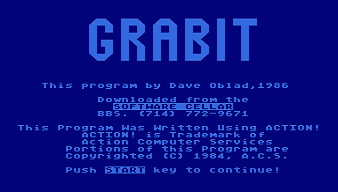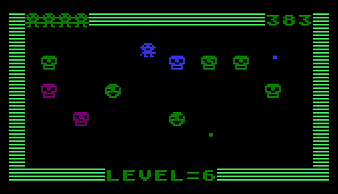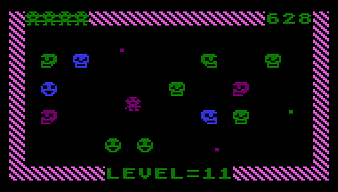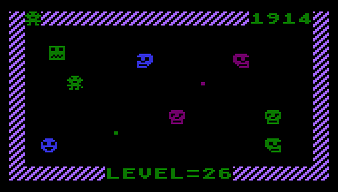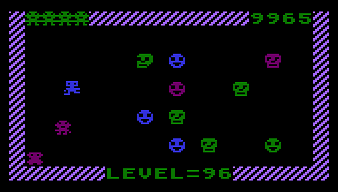GRABIT
A Long-Buried Treasure for Atari Computers
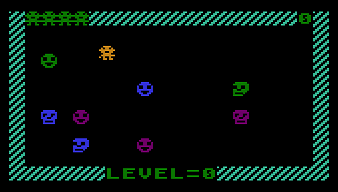
The title of this game should be pronounced "Gray Bit," given the single B; but it's likely that designer / programmer Dave Oblad intended on "Grab It," especially considering that you grab a hell of a lot of things while playing (things on the screen, mind you -- anything else isn't my business). We'll go along with Oblad's wishes, and be grateful enough for his game-creation skills to overlook his iffy spelling ones.
"Grateful" is indeed the word, at least in my case, because I obtained this game for nothing; there's no way to play it these days except as an emulated or copied-and-dumped file. It was apparently never released commerically anyway.
Oblad made his games available on a bulletin-board service called the Software Cellar, which was located in the 714 telephone area code (the Anaheim, California area). The BBS may well have been his own, as I can find no reference to it except on his title screens.
His other Atari programs are the puzzlers Pirate and Matrix, the disappointingly clean XPoker and a colorful, smoothly scrolling version of the mainframe classic Hunt the Wumpus, which he failed to effectively disguise behind his new name for it, Wumpus Hunter. He completed all of these in 1985. Labyrinth, another puzzle game, and Grabit, easily the best and most original, were done a year later. He wrote all of the above in a language called Action!, an '84 creation of the very appropriately named Action Computer Services.
One screen of instructions follows the title, but they're not very instructive. Even after reading them a couple of times, I figured out what I was doing via trial and error. It's a shame that he didn't write prose like he coded; as easy to play and deceptively simple-looking as it is, Grabit is an intricate, brilliantly balanced concert of complementary elements and gradually added ante-ups.
It's easy to get hooked, because, as in all great games, playing repeatedly and developing the skills necessary to improvise are rewarded. Randomness rules the day and patterns would never work. Bravo, Dave!
Externally imposed as any plot tends to be, given that the game-play itself is the actual, unfolding "story," Oblad is concerned to explain that our character is stealing Skulls from a dig site. It's unclear whether he's the archaeologist or just some guy who's wandered up and really likes Skulls. Either way, he must have happened to leave the house with one massive sack.
The instructions go on: "The curse of death to all outsiders looms over the site. To avoid the curse, one simply grabs a Tribal Token."
While no curse makes itself overtly known
-- it's not as if our man ever drops dead for no reason -- taking a Token, which looks like a winking medallion, will indeed make certain collisions beneficial rather than harmful, depending on the Token's color. I'll get to that.
"Watch out for all Falling Rocks..." the next sentence begins. These are dots that zoom diagonally around the screen, constantly rebounding off the four-walled border. They're actually more like skipping stones. If one hits our Skull fetishist, it certainly doesn't bother with any of that fancy "curse" stuff. It just kills him.
A blessing fortunately looms over the site as well, if a blessing can be said to loom, as he's resurrected four times before his burglary days are over.
"...and the Spirits of Past, Present and Future." As with the Skull and Token colors, these are not explained at all. Good thing you have OC&GS! We'll put ya right, mate.
The point values are listed next. Each Token fetches one measly point. Its real value, however, is in empowering your character to pick up a Skull of the same color. To this effect, every Token or Skull is either blue, green or red. The on-screen "you" is vulnerably yellow when the game starts; grab a blue Token (for example) to turn blue and steal any matching Skull for ten points.
Run into a Skull of another color and it's curtains, unless you've dyed yourself that other color in the meantime. You really have to pay attention while navigating, as you run fast and it's easy to collide with a lethal Skull on your way to the right-colored one for which you're actually headed.
The same colors are assumed by the Rocks, i.e. flying periods (talk about the end of the honeymoon phase), with one of those present always changing when our Skull thief does. I therefore reckoned that if I were, say, green, the corresponding Rock would pass through me or bounce off. I found out the hard way that Oblad meant it when he told us to "watch out for all Falling Rocks." Still, it would have been a clever addition. Has anyone got a time machine and a phone book?
The instructions then explain that an additional resurrection is granted for every 1,000 points earned -- and believe me, your eyes are constantly darting up to the score, just to see how close you are to your next extra, especially when you're out of reserves.
"Use joystick, trigger does nothing." Well, maybe English is ol' Dave's second language. Or possibly third, since he's clearly damn good with Action!. Finally we read, "Start key restarts game anytime." I like that in a Start key.
Irrespective of how many already exist, from zero to five randomly mixed Tokens and / or Skulls simultaneously pop onto the playfield every four seconds. They show up in any of thirty-two positions (eight by four).
Either kind of object can appear exactly where you're standing, so whenever you hear the surprisingly non-annoying whistle that warns of an impending materialization, run to the perimeter before the sound ends with a funny "bloik" and the objects finally arrive.
Once you've gotten the hang of judging space and speed, you can even wait between two occupied / possibly-about-to-be-occupied positions. It certainly doesn't take long to pick up the rhythm of the whistles. One thing with which you don't have to concern yourself is the surrounding wall; it doesn't kill you when you run into it. I like that in a wall.
The proceedings begin on Level 0 for some reason. The number increments upon every third appearance of objects, which of course means every twelve seconds. When 0 turns to 1, the first Rock "falls" to the southeast from the northwestern corner of the screen, whence they'll all be entering (making that spot another good one to avoid when you hear the whistle).
When 2 begins, your slow but inertially impressive adversary vanishes, its replacement flying in at a medium velocity. On 3, it's joined by a slow one.
And so on: Each new level brings in from one to four Rocks, the multiples often traveling on different trajectories at different speeds. The possibilities are slow, medium, fast and very fast. The number of rocks will sometimes decrease, but only if one is now faster than the previously fastest. The level-by-level sequence of Rock combinations is one of the game's few non-random aspects.
Level 7 is the first on which three Rocks barge in, and you don't face four until 15. If one kills you, you can at least take heart in its own disintegration, along with that of all others present. This actually happens when you die for any reason, including collision with a Skull of the wrong color. The Rocks don't re-join the action until the level number next increases, at which time they'll all come in from the corner at once, flying to the southeast as usual. Their arbitrary deflections off the objects, however, will soon vary their headings.
It's cool that you're given that break. It takes anyone a while to recuperate from death, after all. What sucks is when you're just starting out on your new life, eager for the future, and the level happens to advance at the very next "bloik," bringing its skipping stones with it. "Hey!" I shout at those dots -- suggesting that I might want to leave the house more often, granted -- when I've been caught unawares and instantly hit. "Have some respect for the formerly dead!"
A Rock will always rebound off the border at ninety degrees diagonally, rather than simply reversing (unless it flies straight into a corner). When it collides with a Token or Skull, it either retains its direction or bounces off at an unpredictable angle of three. It also either destroys the object or leaves it intact. Subtle, chance occurrences like these last two help to make Grabit a more detailed, comprehensively considered game than it might seem at first.
On that note, new elements are so gradually introduced that they feel like rewards. Not until Level 16, for instance, does the Spirit of the Past make his entrance. I've nicknamed him "Ugly," as he's clearly pulled a green bag over his entire body and drawn a face on it.
He appears in the usual corner and drifts slowly toward you, tracking your every movement and arrogantly floating through anything in his way. To send him back to when he came from, just handle him like a green Skull: Swipe a green Token (unless you've learned to be prepared before the level begins) and rub him out.
Because he's relatively slow, Ugly is pretty easy to evade as you head for a green Token or wait for one to show up. He's also easy to catch when you've changed yourself from prey into predator: Once you look like him, any Spirit becomes a coward and flees. This doesn't speak very highly of his self-esteem. When he reaches a corner, he freezes until your approach sends him off again. He doesn't care where he goes, as long as it's away from you. It's pretty funny.
The blue Spirit of the Present, who I call "Furnace Face," is faster and thus tougher to vanquish. He turns up on Level 32. Twenty later, he and Ugly both want to play. Finally, the red Spirit of the Future ("Tent Belly") arrives on Level 64, and he's very fast, hard to dodge and, once you're relieved to be red yourself, chase around -- particularly if the playfield is speckled with non-red Skulls, and / or Tokens that will make you vulnerable to him.
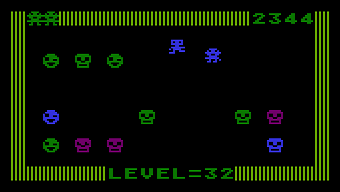
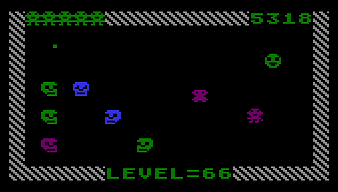
As the instructions indicate -- even if they're not clear until you've played a lot or read this article -- the big points, and hence the real progress toward extra grave-robbers, lie in your repeatedly banishing Ugly (25), Furnace Face (50) and Tent Belly (100) from the proceedings. These rewards add up, as once Ugly has made his first appearance, no level lacks Spirit, as it were.
All three behave identically, apart from their speeds. Two of the same kind never exist at once. If you let one survive from one level to the next, he'll stay on his present route; like any Rocks that get to remain, he's never relocated to the entrance corner. Only new deadly things come in that way.
Whenever a Spirit, duo or trio is seen for the first time, all Rocks disappear until the next level. This brings us to the one exception to the constant presence of ever faster flying periods (apart from your post-death): The amount always resets to a single slow one. This is surely done to let you grow accustomed to dealing with the new Spirit or combo in tandem with bouncing dots. The slow bouncer is always joined by others of gradually increasing speeds as the levels progress, of course.
You're advised to avoid grabbing Tokens you don't need, as you might end up wishing later that they were still available. Yes, one of the Rocks might demolish any of them in the meantime, but it's a chance worth taking by far.
Admittedly, whenever several Skulls of a certain color fill most of the screen, and you've been waiting forever for the appearance of a matching Token, it's incredibly satisfying when it finally turns up and you snatch it and quickly wipe the screen of Skulls, peripherally noting your score rolling up and up like a pinball tally.
You'll find yourself devising strategies that make the game's initially hidden complexity work for you. In my case, these include remaining the color of whichever Spirit has been greeting each recent level change, or, when I know that a combination of two or three is imminent, keeping myself dyed like the fastest -- unless I see that I'll be able to change back after wiping out the other(s).
Between their appearances, I do nothing but dodge Rocks, only taking a non-matching Token when several corresponding Skulls beckon. These let me clean up score-wise before I anxiously await a Token that will change me back. Once the mixture of Spirits regularly includes Tent Belly, I only tend to do that if the change-back already exists, so I can plan on darting over and grabbing it immediately after my Skull sweep.
Making the Rocks capable of pulverizing items is how Oblad admirably prevents the happenstance of a game-stopping screen: thirty-two Skulls that you can't pick up because you're colored otherwise. While such an occurrence is highly unlikely anyway, the fact that it's utterly impossible is yet another testament to his sense of balance and thorough programming.
The occasional Rock is even given more than one chance at taking out a Token or Skull that it happens to hit, as it comically gets trapped in the gaps between the object's pixels, bouncing around inside it for about a second before finally flying off.
Ugly and Tent Belly arrive together on Level 80. I've cheated only once, saving the state of RAM, so I could determine the subsequent Spirit assortments. The things we do for you people! Furnace Face and Tent Belly simultaneously attack on Level 96, and 112 brings in all three Spirits, who remain.
Level 127 is the highest. My birthday! (No, I wasn't born in 1927, ya jerks.) What happens instead of advancement to 128 is that all Spirits, or at least those you haven't wiped out, reappear in their corner with every "bloik" instead of each level-change like normal. All four Rocks are in play by this point, moving at all four speeds. Sounds easy, right?
In truth, you only have to deal with three of those damn flying dots on every other level (if we still consider a level to consist of three "bloiks," even when the number is perpetually 127). This is because of something that's been going on for a while now.
Once you've reached 10,000 points, which usually occurs even before Level 100, the slowest Rock appears inside the western wall when every second level begins. It remains stuck inside throughout, traveling vertically but wiggling back and forth in its very limited bounces. You still have to be careful near that edge whenever the prisoner happens to slightly touch the playfield.
It disappears when the level number next rises. I'm not sure if this is all a bug or an intentional, minor break for the player, but in either case, I appreciate it. By the time the game stays on 127, the slow Rock joins the action whenever it's free, instead of going away. Hmph.
My personal record is 10,350 (Level 95). This is partially due to the happy lack of a lives-left maximum. The session, which took place on March 16, 2022, ended after just over 25 minutes. I know this because I documented the whole game, thanks to the "Record Video" feature in the superb emulator Altirra, with which Adam provided me, along with most all other emulators I use -- thanks again, ol' pal!
Incidentally, I use the term "documented" because "recorded" only pertains to audio, at least in this '70s / '80s brain, which also uses the word "films" instead of "videos," probably because of the negative MTV connotations of the latter.
Ephemeral to the game-play itself as they might be, graphical touches solidify the impression of a carefully crafted, thoughtfully detailed piece of software: Not only do the Tokens' eyes alternatingly wink at you (in fact, they wink so maniacally that they appear to be infected, making one wonder what germs a Tribal Token could possibly pick up), but some Skulls waggle back and forth, as if they actually hope this will persuade you not to steal them.
What's especially impressive is that multiple items don't necessarily wink or waggle in tandem. What's more, each Spirit exhibits his own type of animation.
This fast, smooth and always different game is great fun no matter how many times one is compelled to play again and try to get just a bit better, just a bit farther, just a bit more spot-on with the impromptu brain work. This isn't to mention that "Rhythm of the Whistles" would be an awesome name for a Scottish folk tune.
